Analyzing the EFQM Model's Impact on Squire Group of Hotels
VerifiedAdded on 2023/01/16
|16
|3792
|75
Report
AI Summary
This report provides an in-depth analysis of the EFQM (European Foundation for Quality Management) model, a quality management framework based on Total Quality Management (TQM) principles. The report examines the EFQM model's structure, which includes enablers (leadership, policy & strategy, people, partnerships & resources, processes) and results (people results, customer results, society results, key performance results). It uses Squire Group Hotels as a case study, exploring how the model can be applied to improve the hotel's performance, address challenges like low weekend occupancy and lack of customer feedback mechanisms, and achieve business excellence. The report also discusses the RADAR model, successful EFQM implementations in companies like Objectivity PLC, Siemens, and Baines & Ernst, and the limitations of the EFQM model. Furthermore, the report emphasizes the importance of measuring performance, identifying benchmarks, and the benefits of investing in excellence, highlighting the positive changes reported by organizations using the model. The report concludes with recommendations on how Squire Hotels can leverage the EFQM model to improve its service quality and overall performance.

SERVICE MARKETING MANAGEMENT
Student’s Name
Course Name
Professor’s Name
University Name
City, State
Date
Student’s Name
Course Name
Professor’s Name
University Name
City, State
Date
Paraphrase This Document
Need a fresh take? Get an instant paraphrase of this document with our AI Paraphraser
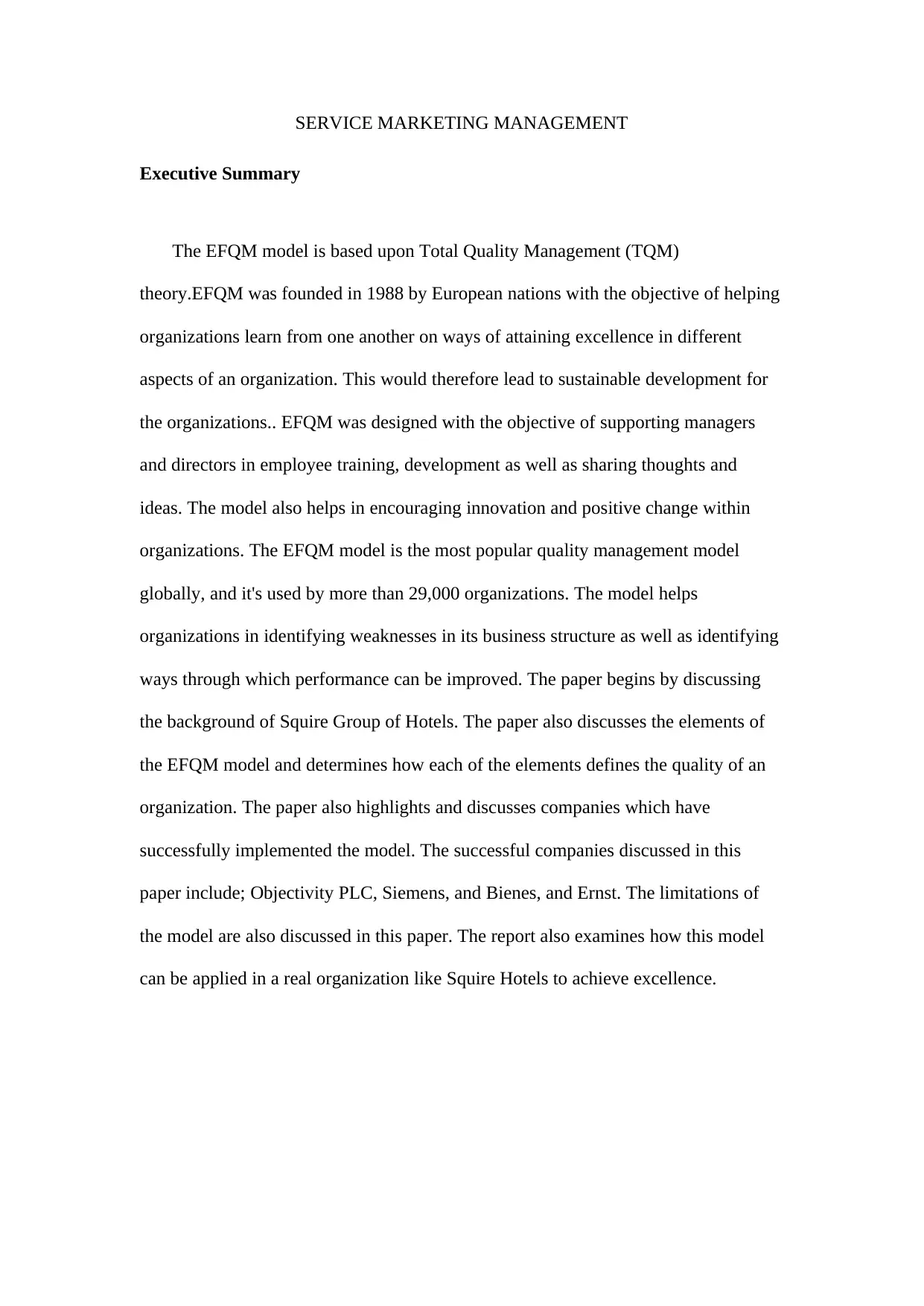
SERVICE MARKETING MANAGEMENT
Executive Summary
The EFQM model is based upon Total Quality Management (TQM)
theory.EFQM was founded in 1988 by European nations with the objective of helping
organizations learn from one another on ways of attaining excellence in different
aspects of an organization. This would therefore lead to sustainable development for
the organizations.. EFQM was designed with the objective of supporting managers
and directors in employee training, development as well as sharing thoughts and
ideas. The model also helps in encouraging innovation and positive change within
organizations. The EFQM model is the most popular quality management model
globally, and it's used by more than 29,000 organizations. The model helps
organizations in identifying weaknesses in its business structure as well as identifying
ways through which performance can be improved. The paper begins by discussing
the background of Squire Group of Hotels. The paper also discusses the elements of
the EFQM model and determines how each of the elements defines the quality of an
organization. The paper also highlights and discusses companies which have
successfully implemented the model. The successful companies discussed in this
paper include; Objectivity PLC, Siemens, and Bienes, and Ernst. The limitations of
the model are also discussed in this paper. The report also examines how this model
can be applied in a real organization like Squire Hotels to achieve excellence.
Executive Summary
The EFQM model is based upon Total Quality Management (TQM)
theory.EFQM was founded in 1988 by European nations with the objective of helping
organizations learn from one another on ways of attaining excellence in different
aspects of an organization. This would therefore lead to sustainable development for
the organizations.. EFQM was designed with the objective of supporting managers
and directors in employee training, development as well as sharing thoughts and
ideas. The model also helps in encouraging innovation and positive change within
organizations. The EFQM model is the most popular quality management model
globally, and it's used by more than 29,000 organizations. The model helps
organizations in identifying weaknesses in its business structure as well as identifying
ways through which performance can be improved. The paper begins by discussing
the background of Squire Group of Hotels. The paper also discusses the elements of
the EFQM model and determines how each of the elements defines the quality of an
organization. The paper also highlights and discusses companies which have
successfully implemented the model. The successful companies discussed in this
paper include; Objectivity PLC, Siemens, and Bienes, and Ernst. The limitations of
the model are also discussed in this paper. The report also examines how this model
can be applied in a real organization like Squire Hotels to achieve excellence.
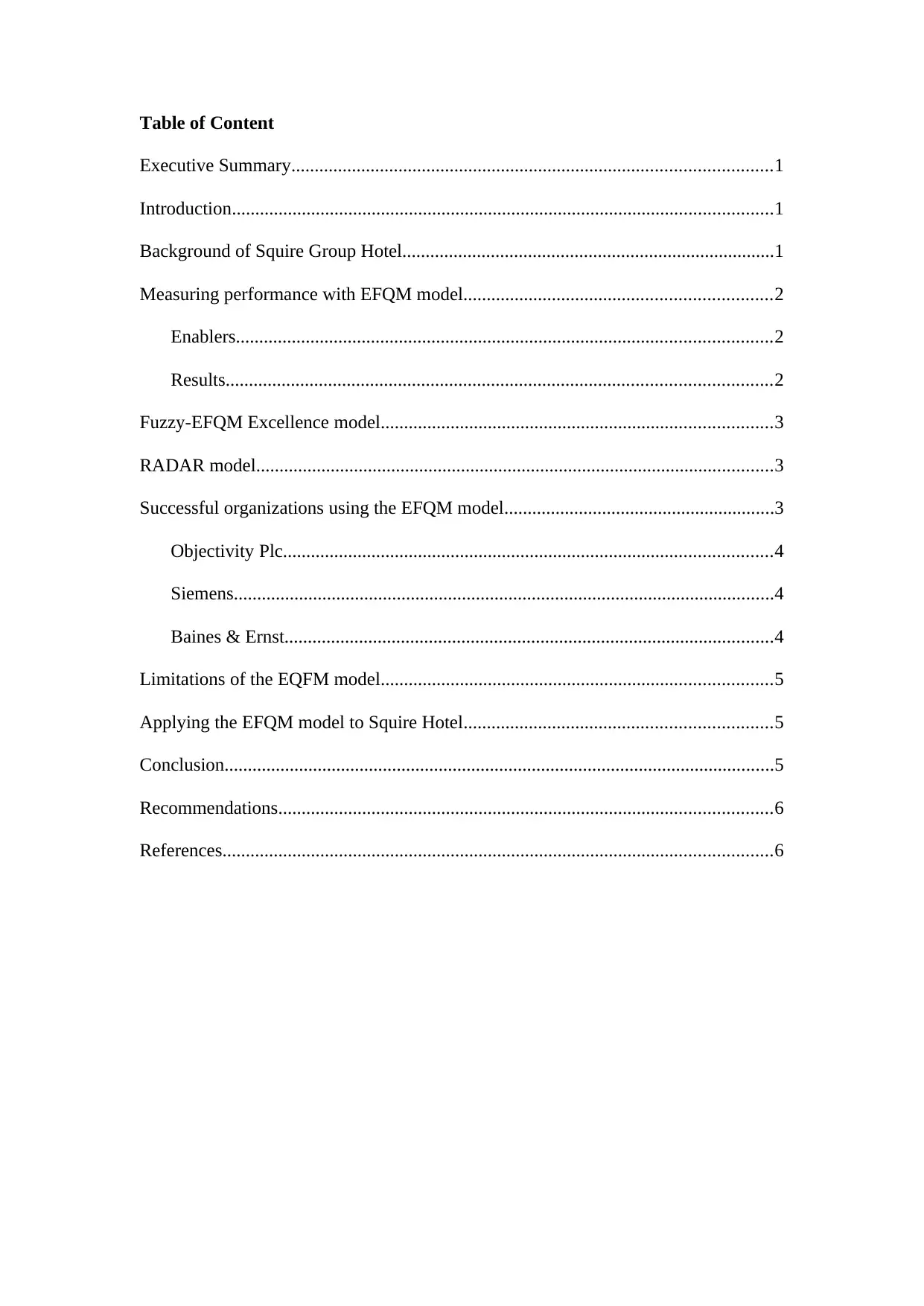
Table of Content
Executive Summary.......................................................................................................1
Introduction....................................................................................................................1
Background of Squire Group Hotel................................................................................1
Measuring performance with EFQM model..................................................................2
Enablers...................................................................................................................2
Results.....................................................................................................................2
Fuzzy-EFQM Excellence model....................................................................................3
RADAR model...............................................................................................................3
Successful organizations using the EFQM model..........................................................3
Objectivity Plc.........................................................................................................4
Siemens....................................................................................................................4
Baines & Ernst.........................................................................................................4
Limitations of the EQFM model....................................................................................5
Applying the EFQM model to Squire Hotel..................................................................5
Conclusion......................................................................................................................5
Recommendations..........................................................................................................6
References......................................................................................................................6
Executive Summary.......................................................................................................1
Introduction....................................................................................................................1
Background of Squire Group Hotel................................................................................1
Measuring performance with EFQM model..................................................................2
Enablers...................................................................................................................2
Results.....................................................................................................................2
Fuzzy-EFQM Excellence model....................................................................................3
RADAR model...............................................................................................................3
Successful organizations using the EFQM model..........................................................3
Objectivity Plc.........................................................................................................4
Siemens....................................................................................................................4
Baines & Ernst.........................................................................................................4
Limitations of the EQFM model....................................................................................5
Applying the EFQM model to Squire Hotel..................................................................5
Conclusion......................................................................................................................5
Recommendations..........................................................................................................6
References......................................................................................................................6
⊘ This is a preview!⊘
Do you want full access?
Subscribe today to unlock all pages.

Trusted by 1+ million students worldwide
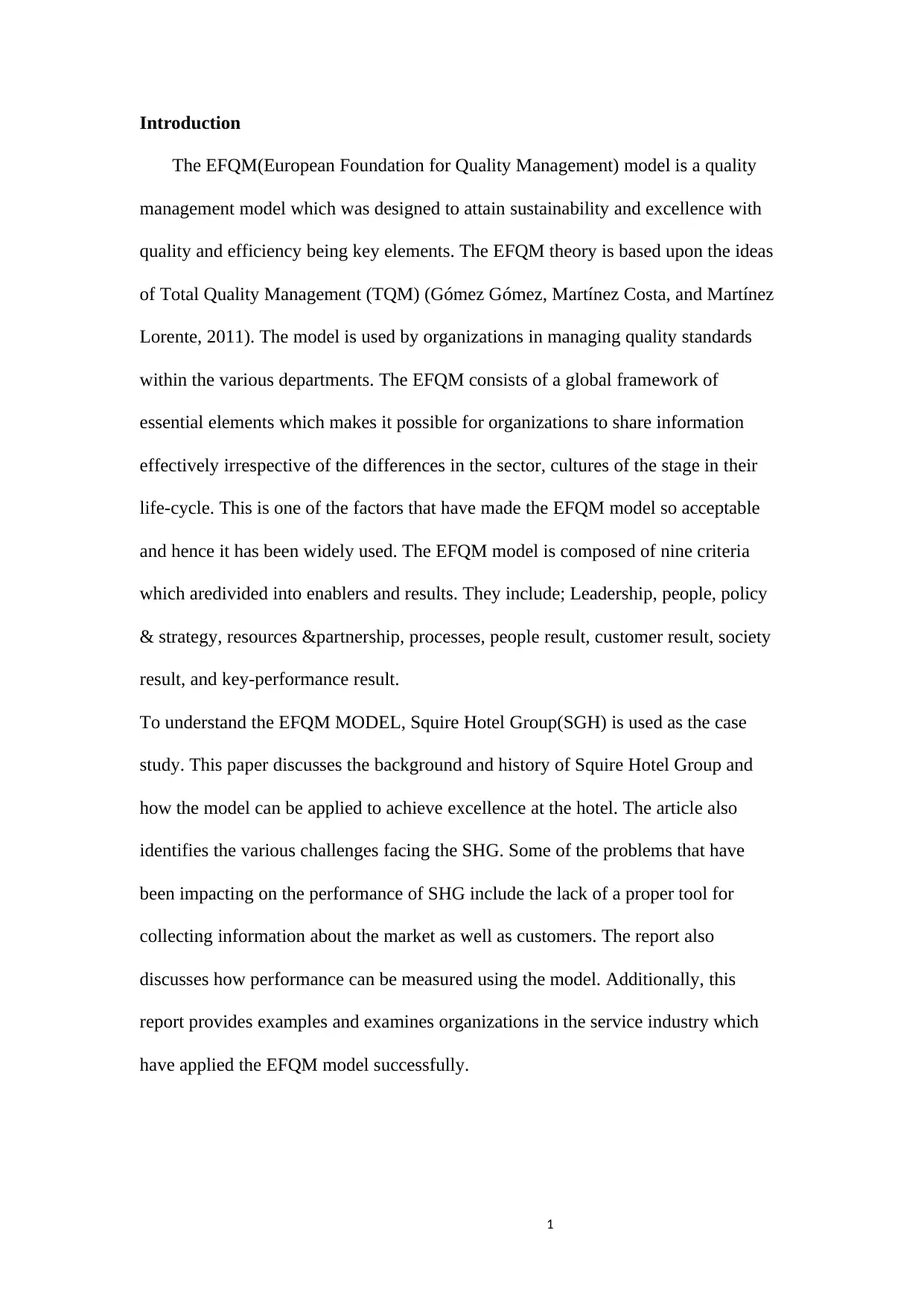
1
Introduction
The EFQM(European Foundation for Quality Management) model is a quality
management model which was designed to attain sustainability and excellence with
quality and efficiency being key elements. The EFQM theory is based upon the ideas
of Total Quality Management (TQM) (Gómez Gómez, Martínez Costa, and Martínez
Lorente, 2011). The model is used by organizations in managing quality standards
within the various departments. The EFQM consists of a global framework of
essential elements which makes it possible for organizations to share information
effectively irrespective of the differences in the sector, cultures of the stage in their
life-cycle. This is one of the factors that have made the EFQM model so acceptable
and hence it has been widely used. The EFQM model is composed of nine criteria
which aredivided into enablers and results. They include; Leadership, people, policy
& strategy, resources &partnership, processes, people result, customer result, society
result, and key-performance result.
To understand the EFQM MODEL, Squire Hotel Group(SGH) is used as the case
study. This paper discusses the background and history of Squire Hotel Group and
how the model can be applied to achieve excellence at the hotel. The article also
identifies the various challenges facing the SHG. Some of the problems that have
been impacting on the performance of SHG include the lack of a proper tool for
collecting information about the market as well as customers. The report also
discusses how performance can be measured using the model. Additionally, this
report provides examples and examines organizations in the service industry which
have applied the EFQM model successfully.
Introduction
The EFQM(European Foundation for Quality Management) model is a quality
management model which was designed to attain sustainability and excellence with
quality and efficiency being key elements. The EFQM theory is based upon the ideas
of Total Quality Management (TQM) (Gómez Gómez, Martínez Costa, and Martínez
Lorente, 2011). The model is used by organizations in managing quality standards
within the various departments. The EFQM consists of a global framework of
essential elements which makes it possible for organizations to share information
effectively irrespective of the differences in the sector, cultures of the stage in their
life-cycle. This is one of the factors that have made the EFQM model so acceptable
and hence it has been widely used. The EFQM model is composed of nine criteria
which aredivided into enablers and results. They include; Leadership, people, policy
& strategy, resources &partnership, processes, people result, customer result, society
result, and key-performance result.
To understand the EFQM MODEL, Squire Hotel Group(SGH) is used as the case
study. This paper discusses the background and history of Squire Hotel Group and
how the model can be applied to achieve excellence at the hotel. The article also
identifies the various challenges facing the SHG. Some of the problems that have
been impacting on the performance of SHG include the lack of a proper tool for
collecting information about the market as well as customers. The report also
discusses how performance can be measured using the model. Additionally, this
report provides examples and examines organizations in the service industry which
have applied the EFQM model successfully.
Paraphrase This Document
Need a fresh take? Get an instant paraphrase of this document with our AI Paraphraser
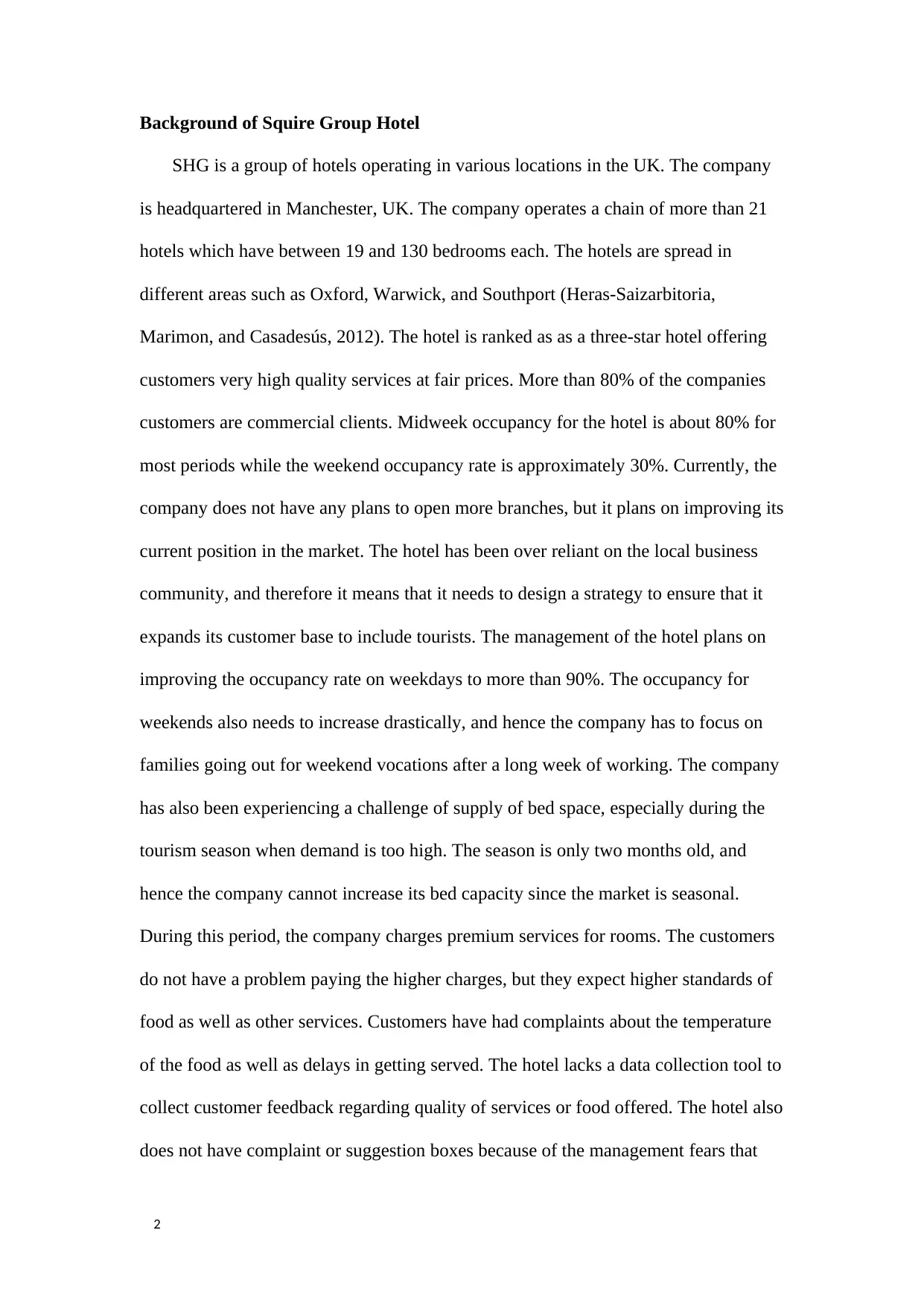
2
Background of Squire Group Hotel
SHG is a group of hotels operating in various locations in the UK. The company
is headquartered in Manchester, UK. The company operates a chain of more than 21
hotels which have between 19 and 130 bedrooms each. The hotels are spread in
different areas such as Oxford, Warwick, and Southport (Heras-Saizarbitoria,
Marimon, and Casadesús, 2012). The hotel is ranked as as a three-star hotel offering
customers very high quality services at fair prices. More than 80% of the companies
customers are commercial clients. Midweek occupancy for the hotel is about 80% for
most periods while the weekend occupancy rate is approximately 30%. Currently, the
company does not have any plans to open more branches, but it plans on improving its
current position in the market. The hotel has been over reliant on the local business
community, and therefore it means that it needs to design a strategy to ensure that it
expands its customer base to include tourists. The management of the hotel plans on
improving the occupancy rate on weekdays to more than 90%. The occupancy for
weekends also needs to increase drastically, and hence the company has to focus on
families going out for weekend vocations after a long week of working. The company
has also been experiencing a challenge of supply of bed space, especially during the
tourism season when demand is too high. The season is only two months old, and
hence the company cannot increase its bed capacity since the market is seasonal.
During this period, the company charges premium services for rooms. The customers
do not have a problem paying the higher charges, but they expect higher standards of
food as well as other services. Customers have had complaints about the temperature
of the food as well as delays in getting served. The hotel lacks a data collection tool to
collect customer feedback regarding quality of services or food offered. The hotel also
does not have complaint or suggestion boxes because of the management fears that
Background of Squire Group Hotel
SHG is a group of hotels operating in various locations in the UK. The company
is headquartered in Manchester, UK. The company operates a chain of more than 21
hotels which have between 19 and 130 bedrooms each. The hotels are spread in
different areas such as Oxford, Warwick, and Southport (Heras-Saizarbitoria,
Marimon, and Casadesús, 2012). The hotel is ranked as as a three-star hotel offering
customers very high quality services at fair prices. More than 80% of the companies
customers are commercial clients. Midweek occupancy for the hotel is about 80% for
most periods while the weekend occupancy rate is approximately 30%. Currently, the
company does not have any plans to open more branches, but it plans on improving its
current position in the market. The hotel has been over reliant on the local business
community, and therefore it means that it needs to design a strategy to ensure that it
expands its customer base to include tourists. The management of the hotel plans on
improving the occupancy rate on weekdays to more than 90%. The occupancy for
weekends also needs to increase drastically, and hence the company has to focus on
families going out for weekend vocations after a long week of working. The company
has also been experiencing a challenge of supply of bed space, especially during the
tourism season when demand is too high. The season is only two months old, and
hence the company cannot increase its bed capacity since the market is seasonal.
During this period, the company charges premium services for rooms. The customers
do not have a problem paying the higher charges, but they expect higher standards of
food as well as other services. Customers have had complaints about the temperature
of the food as well as delays in getting served. The hotel lacks a data collection tool to
collect customer feedback regarding quality of services or food offered. The hotel also
does not have complaint or suggestion boxes because of the management fears that

3
customers may complain too much or question the services. Another issue that can be
identified with Squire Hotel is that the company does not have a method of assessing
the happiness and morale of employees which is critical in determining the
performance of an organization.
Measuring performance with EFQM model
For an organization to measure its performance using the EFQM model, it has to
identify a high quality organization which should act a benchmark against which its
performance can be compared. The model is made up of enablers and results. The
facilitators include; people, policy & strategy, leadership,partnership & resources as
well as processes. The model is read from right to left. The results include: people
results, customer results, society results, and key performance results. Measurement
of quality in an organization using this model begins with reviewing results. Enablers
in the model support the structure, rules and procedures set by the organization in
order to enable the organization achieve excellence. Results in an organization
concentrate on achievements which are related to the stakeholders of the organization.
Key Concept of EFQM model
Enablers
Leadership- The model says that good leaders are able to develop the mission and
goals of the organization as well as ensure the achievement of the set goals. Good
leaders develop organizational values and put in place structures and policies required
to achieve success and to ensure sustainable development within the organization. The
behavior and actions of the leader should be positive and worth emulating by other
members of the organization. The behavior should also mirror the values and culture
of the company.
customers may complain too much or question the services. Another issue that can be
identified with Squire Hotel is that the company does not have a method of assessing
the happiness and morale of employees which is critical in determining the
performance of an organization.
Measuring performance with EFQM model
For an organization to measure its performance using the EFQM model, it has to
identify a high quality organization which should act a benchmark against which its
performance can be compared. The model is made up of enablers and results. The
facilitators include; people, policy & strategy, leadership,partnership & resources as
well as processes. The model is read from right to left. The results include: people
results, customer results, society results, and key performance results. Measurement
of quality in an organization using this model begins with reviewing results. Enablers
in the model support the structure, rules and procedures set by the organization in
order to enable the organization achieve excellence. Results in an organization
concentrate on achievements which are related to the stakeholders of the organization.
Key Concept of EFQM model
Enablers
Leadership- The model says that good leaders are able to develop the mission and
goals of the organization as well as ensure the achievement of the set goals. Good
leaders develop organizational values and put in place structures and policies required
to achieve success and to ensure sustainable development within the organization. The
behavior and actions of the leader should be positive and worth emulating by other
members of the organization. The behavior should also mirror the values and culture
of the company.
⊘ This is a preview!⊘
Do you want full access?
Subscribe today to unlock all pages.

Trusted by 1+ million students worldwide

4
Policy and strategy-Aside from developing the mission and vision of an
organization, excellent leaders develop strategies and policies which involve all
stakeholders to achieve the set mission and objectives. Good leaders understand the
importance of designing strategies that are tailor-made for the market and the specific
organization. They also understand the importance of involving every stakeholder
who will be involved in the implementation of the policies and strategies.
Results
People- high quality organizations recruit manage and develop the talent of
employees at individual levels, organizational level, and group level. By doing this,
the organization equips people with skills and knowledge which are critical for future
growth of the company.
Partnerships and resources- quality organizations forge meaningful partnerships
which benefit the company positively. A quality organization can negotiate beneficial
deals with partners such as suppliers and other strategic partners. A quality
organization is also able to put in place policies that ensure maximum utilization of
resources within the organization. This provides the sustainable performance of an
organization.
Processes. A great organization can design and improve processes within an
organization. Processes are very important in an organization since they are crucial in
determining the end product. Processes also determine the efficiency of an
organization. This is very critical especially for organizations in the service industry.
Improvement of processes leads to an increase in value for customers and other
stakeholders.
Policy and strategy-Aside from developing the mission and vision of an
organization, excellent leaders develop strategies and policies which involve all
stakeholders to achieve the set mission and objectives. Good leaders understand the
importance of designing strategies that are tailor-made for the market and the specific
organization. They also understand the importance of involving every stakeholder
who will be involved in the implementation of the policies and strategies.
Results
People- high quality organizations recruit manage and develop the talent of
employees at individual levels, organizational level, and group level. By doing this,
the organization equips people with skills and knowledge which are critical for future
growth of the company.
Partnerships and resources- quality organizations forge meaningful partnerships
which benefit the company positively. A quality organization can negotiate beneficial
deals with partners such as suppliers and other strategic partners. A quality
organization is also able to put in place policies that ensure maximum utilization of
resources within the organization. This provides the sustainable performance of an
organization.
Processes. A great organization can design and improve processes within an
organization. Processes are very important in an organization since they are crucial in
determining the end product. Processes also determine the efficiency of an
organization. This is very critical especially for organizations in the service industry.
Improvement of processes leads to an increase in value for customers and other
stakeholders.
Paraphrase This Document
Need a fresh take? Get an instant paraphrase of this document with our AI Paraphraser
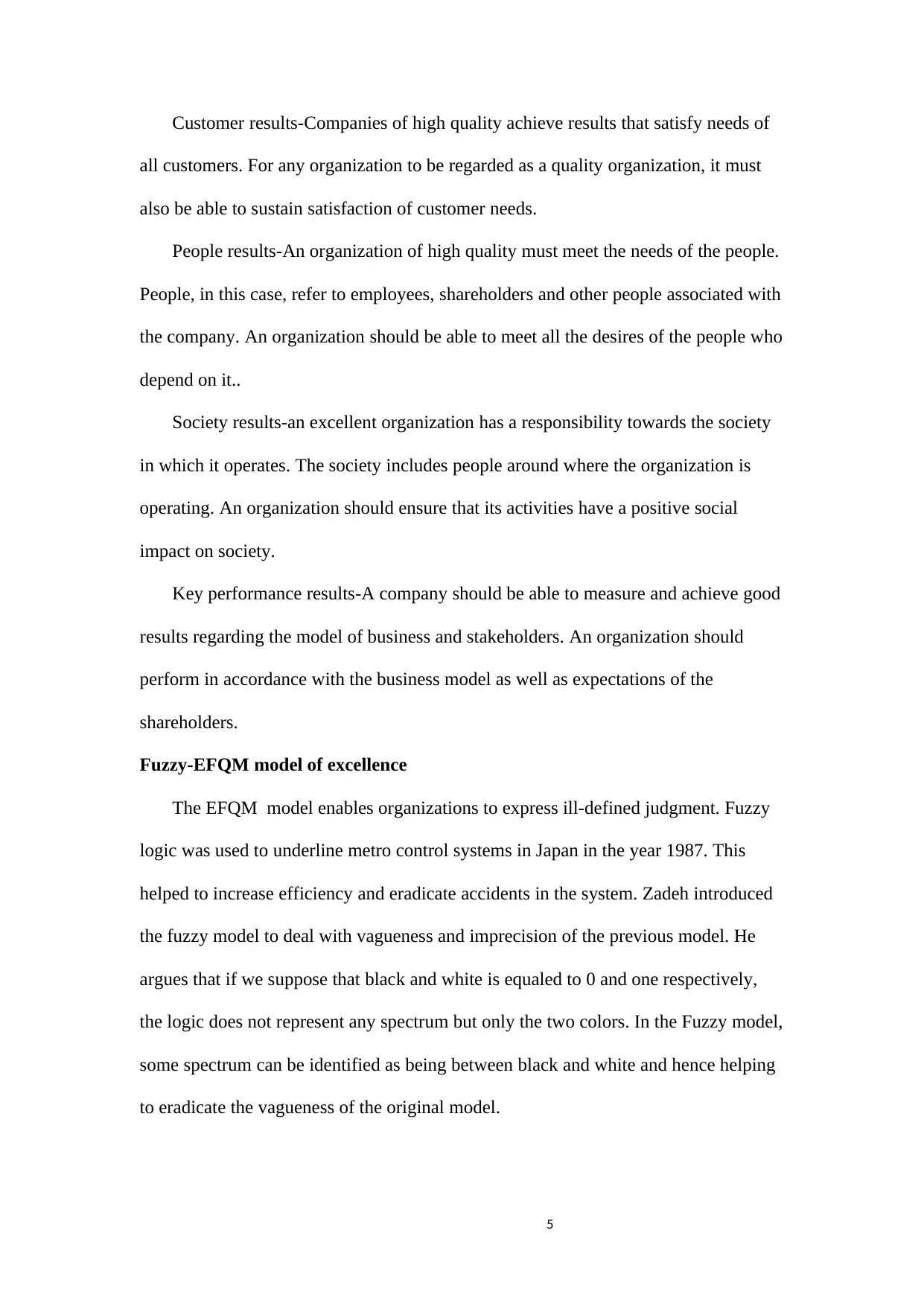
5
Customer results-Companies of high quality achieve results that satisfy needs of
all customers. For any organization to be regarded as a quality organization, it must
also be able to sustain satisfaction of customer needs.
People results-An organization of high quality must meet the needs of the people.
People, in this case, refer to employees, shareholders and other people associated with
the company. An organization should be able to meet all the desires of the people who
depend on it..
Society results-an excellent organization has a responsibility towards the society
in which it operates. The society includes people around where the organization is
operating. An organization should ensure that its activities have a positive social
impact on society.
Key performance results-A company should be able to measure and achieve good
results regarding the model of business and stakeholders. An organization should
perform in accordance with the business model as well as expectations of the
shareholders.
Fuzzy-EFQM model of excellence
The EFQM model enables organizations to express ill-defined judgment. Fuzzy
logic was used to underline metro control systems in Japan in the year 1987. This
helped to increase efficiency and eradicate accidents in the system. Zadeh introduced
the fuzzy model to deal with vagueness and imprecision of the previous model. He
argues that if we suppose that black and white is equaled to 0 and one respectively,
the logic does not represent any spectrum but only the two colors. In the Fuzzy model,
some spectrum can be identified as being between black and white and hence helping
to eradicate the vagueness of the original model.
Customer results-Companies of high quality achieve results that satisfy needs of
all customers. For any organization to be regarded as a quality organization, it must
also be able to sustain satisfaction of customer needs.
People results-An organization of high quality must meet the needs of the people.
People, in this case, refer to employees, shareholders and other people associated with
the company. An organization should be able to meet all the desires of the people who
depend on it..
Society results-an excellent organization has a responsibility towards the society
in which it operates. The society includes people around where the organization is
operating. An organization should ensure that its activities have a positive social
impact on society.
Key performance results-A company should be able to measure and achieve good
results regarding the model of business and stakeholders. An organization should
perform in accordance with the business model as well as expectations of the
shareholders.
Fuzzy-EFQM model of excellence
The EFQM model enables organizations to express ill-defined judgment. Fuzzy
logic was used to underline metro control systems in Japan in the year 1987. This
helped to increase efficiency and eradicate accidents in the system. Zadeh introduced
the fuzzy model to deal with vagueness and imprecision of the previous model. He
argues that if we suppose that black and white is equaled to 0 and one respectively,
the logic does not represent any spectrum but only the two colors. In the Fuzzy model,
some spectrum can be identified as being between black and white and hence helping
to eradicate the vagueness of the original model.
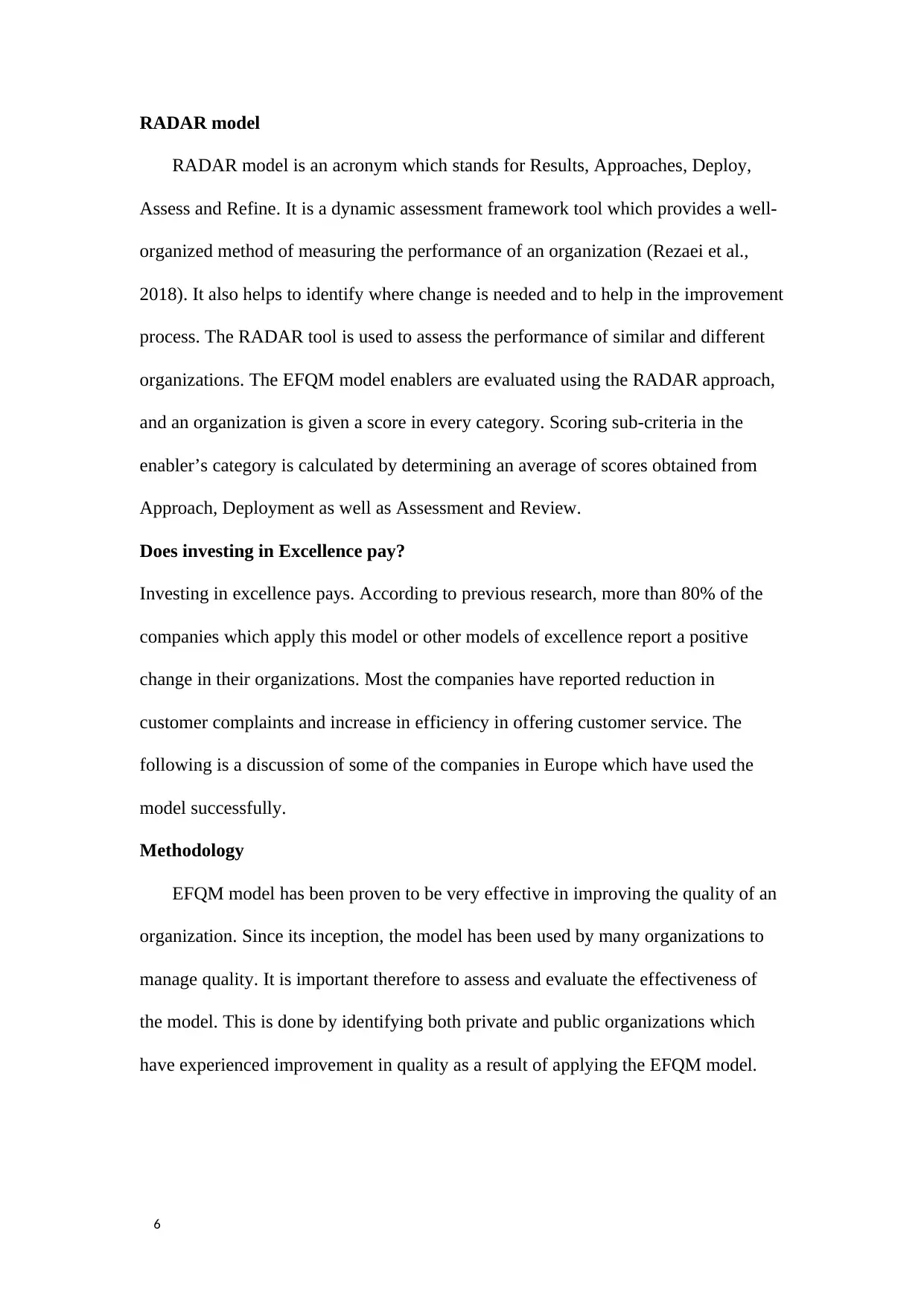
6
RADAR model
RADAR model is an acronym which stands for Results, Approaches, Deploy,
Assess and Refine. It is a dynamic assessment framework tool which provides a well-
organized method of measuring the performance of an organization (Rezaei et al.,
2018). It also helps to identify where change is needed and to help in the improvement
process. The RADAR tool is used to assess the performance of similar and different
organizations. The EFQM model enablers are evaluated using the RADAR approach,
and an organization is given a score in every category. Scoring sub-criteria in the
enabler’s category is calculated by determining an average of scores obtained from
Approach, Deployment as well as Assessment and Review.
Does investing in Excellence pay?
Investing in excellence pays. According to previous research, more than 80% of the
companies which apply this model or other models of excellence report a positive
change in their organizations. Most the companies have reported reduction in
customer complaints and increase in efficiency in offering customer service. The
following is a discussion of some of the companies in Europe which have used the
model successfully.
Methodology
EFQM model has been proven to be very effective in improving the quality of an
organization. Since its inception, the model has been used by many organizations to
manage quality. It is important therefore to assess and evaluate the effectiveness of
the model. This is done by identifying both private and public organizations which
have experienced improvement in quality as a result of applying the EFQM model.
RADAR model
RADAR model is an acronym which stands for Results, Approaches, Deploy,
Assess and Refine. It is a dynamic assessment framework tool which provides a well-
organized method of measuring the performance of an organization (Rezaei et al.,
2018). It also helps to identify where change is needed and to help in the improvement
process. The RADAR tool is used to assess the performance of similar and different
organizations. The EFQM model enablers are evaluated using the RADAR approach,
and an organization is given a score in every category. Scoring sub-criteria in the
enabler’s category is calculated by determining an average of scores obtained from
Approach, Deployment as well as Assessment and Review.
Does investing in Excellence pay?
Investing in excellence pays. According to previous research, more than 80% of the
companies which apply this model or other models of excellence report a positive
change in their organizations. Most the companies have reported reduction in
customer complaints and increase in efficiency in offering customer service. The
following is a discussion of some of the companies in Europe which have used the
model successfully.
Methodology
EFQM model has been proven to be very effective in improving the quality of an
organization. Since its inception, the model has been used by many organizations to
manage quality. It is important therefore to assess and evaluate the effectiveness of
the model. This is done by identifying both private and public organizations which
have experienced improvement in quality as a result of applying the EFQM model.
⊘ This is a preview!⊘
Do you want full access?
Subscribe today to unlock all pages.

Trusted by 1+ million students worldwide
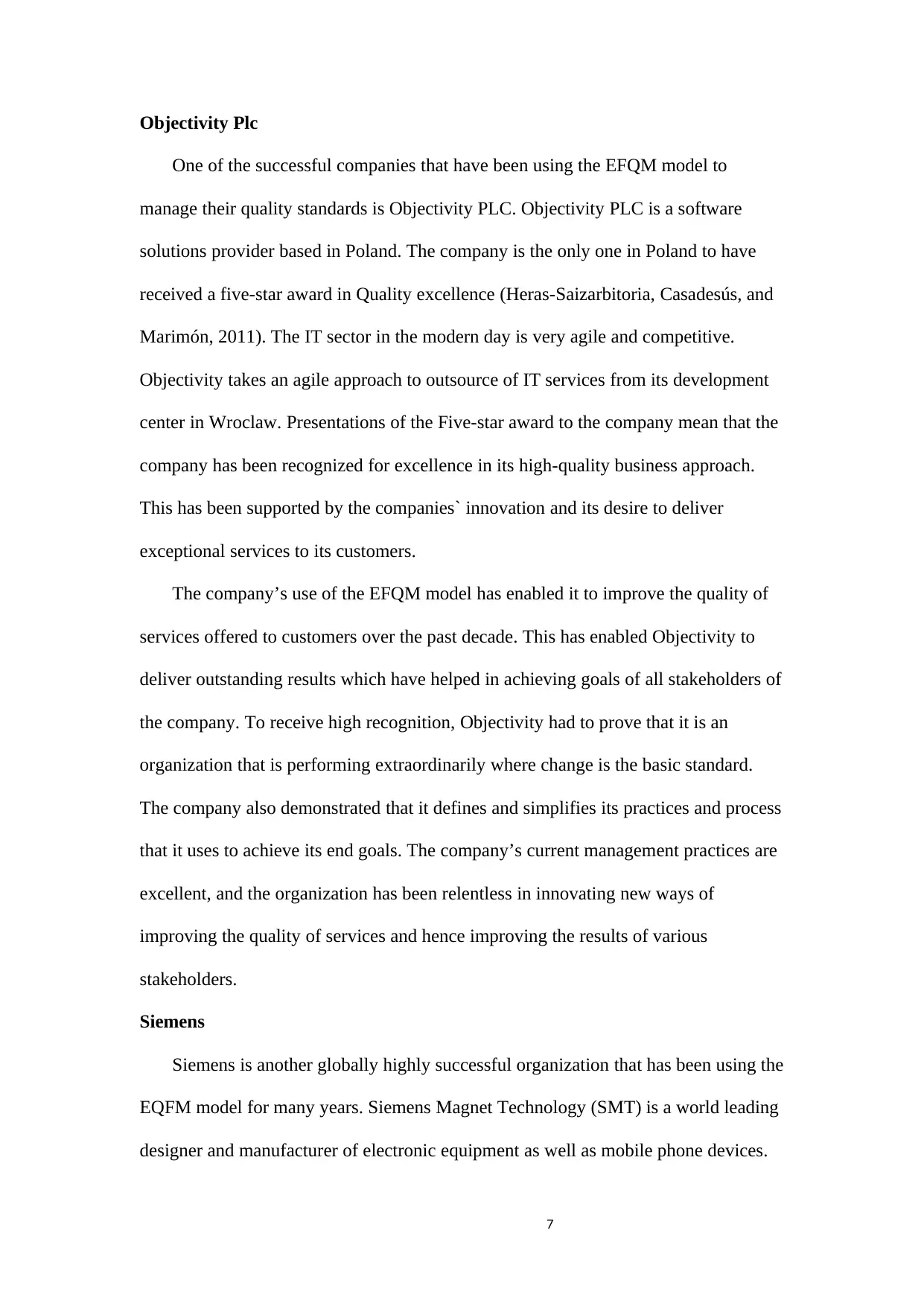
7
Objectivity Plc
One of the successful companies that have been using the EFQM model to
manage their quality standards is Objectivity PLC. Objectivity PLC is a software
solutions provider based in Poland. The company is the only one in Poland to have
received a five-star award in Quality excellence (Heras-Saizarbitoria, Casadesús, and
Marimón, 2011). The IT sector in the modern day is very agile and competitive.
Objectivity takes an agile approach to outsource of IT services from its development
center in Wroclaw. Presentations of the Five-star award to the company mean that the
company has been recognized for excellence in its high-quality business approach.
This has been supported by the companies` innovation and its desire to deliver
exceptional services to its customers.
The company’s use of the EFQM model has enabled it to improve the quality of
services offered to customers over the past decade. This has enabled Objectivity to
deliver outstanding results which have helped in achieving goals of all stakeholders of
the company. To receive high recognition, Objectivity had to prove that it is an
organization that is performing extraordinarily where change is the basic standard.
The company also demonstrated that it defines and simplifies its practices and process
that it uses to achieve its end goals. The company’s current management practices are
excellent, and the organization has been relentless in innovating new ways of
improving the quality of services and hence improving the results of various
stakeholders.
Siemens
Siemens is another globally highly successful organization that has been using the
EQFM model for many years. Siemens Magnet Technology (SMT) is a world leading
designer and manufacturer of electronic equipment as well as mobile phone devices.
Objectivity Plc
One of the successful companies that have been using the EFQM model to
manage their quality standards is Objectivity PLC. Objectivity PLC is a software
solutions provider based in Poland. The company is the only one in Poland to have
received a five-star award in Quality excellence (Heras-Saizarbitoria, Casadesús, and
Marimón, 2011). The IT sector in the modern day is very agile and competitive.
Objectivity takes an agile approach to outsource of IT services from its development
center in Wroclaw. Presentations of the Five-star award to the company mean that the
company has been recognized for excellence in its high-quality business approach.
This has been supported by the companies` innovation and its desire to deliver
exceptional services to its customers.
The company’s use of the EFQM model has enabled it to improve the quality of
services offered to customers over the past decade. This has enabled Objectivity to
deliver outstanding results which have helped in achieving goals of all stakeholders of
the company. To receive high recognition, Objectivity had to prove that it is an
organization that is performing extraordinarily where change is the basic standard.
The company also demonstrated that it defines and simplifies its practices and process
that it uses to achieve its end goals. The company’s current management practices are
excellent, and the organization has been relentless in innovating new ways of
improving the quality of services and hence improving the results of various
stakeholders.
Siemens
Siemens is another globally highly successful organization that has been using the
EQFM model for many years. Siemens Magnet Technology (SMT) is a world leading
designer and manufacturer of electronic equipment as well as mobile phone devices.
Paraphrase This Document
Need a fresh take? Get an instant paraphrase of this document with our AI Paraphraser
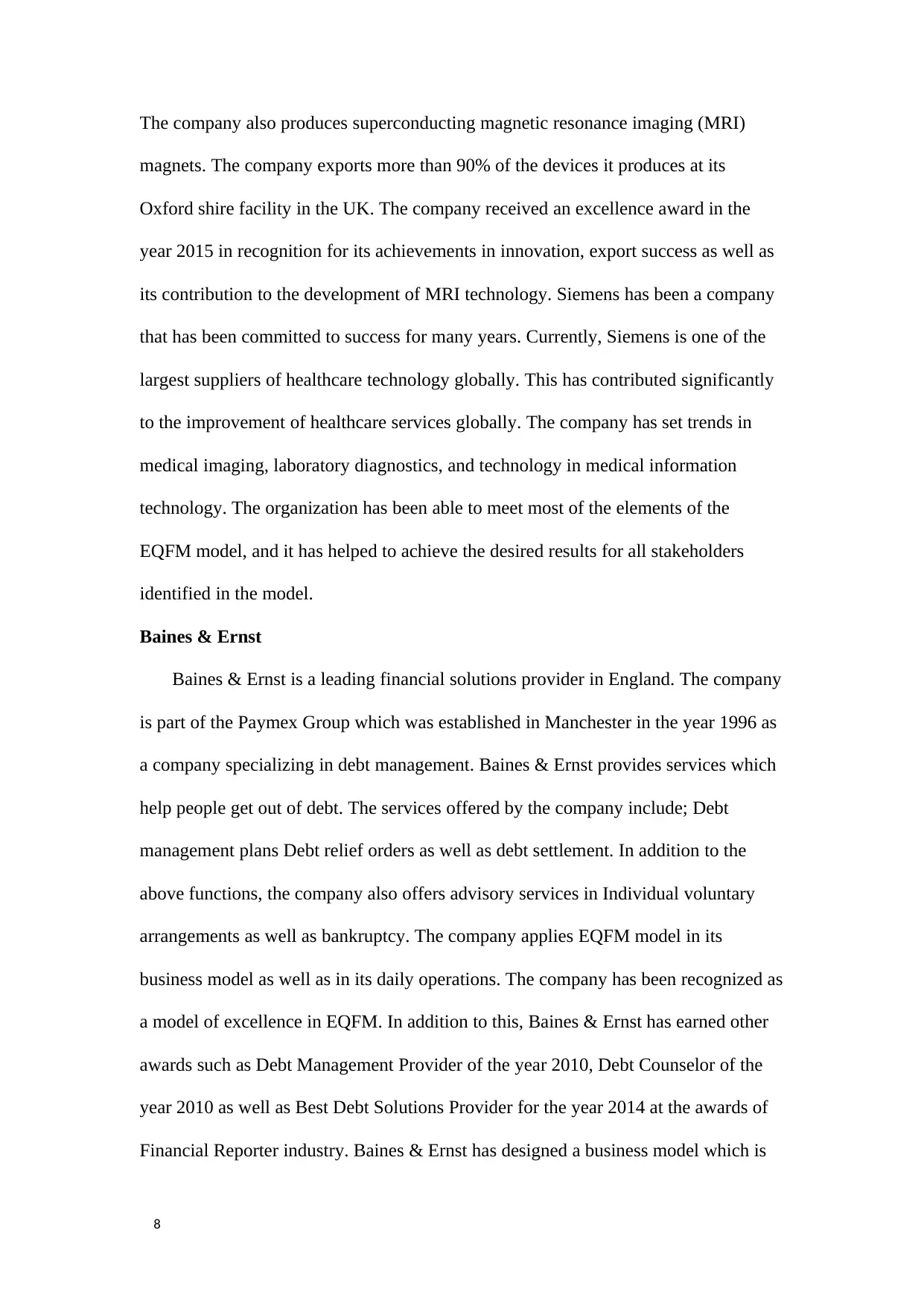
8
The company also produces superconducting magnetic resonance imaging (MRI)
magnets. The company exports more than 90% of the devices it produces at its
Oxford shire facility in the UK. The company received an excellence award in the
year 2015 in recognition for its achievements in innovation, export success as well as
its contribution to the development of MRI technology. Siemens has been a company
that has been committed to success for many years. Currently, Siemens is one of the
largest suppliers of healthcare technology globally. This has contributed significantly
to the improvement of healthcare services globally. The company has set trends in
medical imaging, laboratory diagnostics, and technology in medical information
technology. The organization has been able to meet most of the elements of the
EQFM model, and it has helped to achieve the desired results for all stakeholders
identified in the model.
Baines & Ernst
Baines & Ernst is a leading financial solutions provider in England. The company
is part of the Paymex Group which was established in Manchester in the year 1996 as
a company specializing in debt management. Baines & Ernst provides services which
help people get out of debt. The services offered by the company include; Debt
management plans Debt relief orders as well as debt settlement. In addition to the
above functions, the company also offers advisory services in Individual voluntary
arrangements as well as bankruptcy. The company applies EQFM model in its
business model as well as in its daily operations. The company has been recognized as
a model of excellence in EQFM. In addition to this, Baines & Ernst has earned other
awards such as Debt Management Provider of the year 2010, Debt Counselor of the
year 2010 as well as Best Debt Solutions Provider for the year 2014 at the awards of
Financial Reporter industry. Baines & Ernst has designed a business model which is
The company also produces superconducting magnetic resonance imaging (MRI)
magnets. The company exports more than 90% of the devices it produces at its
Oxford shire facility in the UK. The company received an excellence award in the
year 2015 in recognition for its achievements in innovation, export success as well as
its contribution to the development of MRI technology. Siemens has been a company
that has been committed to success for many years. Currently, Siemens is one of the
largest suppliers of healthcare technology globally. This has contributed significantly
to the improvement of healthcare services globally. The company has set trends in
medical imaging, laboratory diagnostics, and technology in medical information
technology. The organization has been able to meet most of the elements of the
EQFM model, and it has helped to achieve the desired results for all stakeholders
identified in the model.
Baines & Ernst
Baines & Ernst is a leading financial solutions provider in England. The company
is part of the Paymex Group which was established in Manchester in the year 1996 as
a company specializing in debt management. Baines & Ernst provides services which
help people get out of debt. The services offered by the company include; Debt
management plans Debt relief orders as well as debt settlement. In addition to the
above functions, the company also offers advisory services in Individual voluntary
arrangements as well as bankruptcy. The company applies EQFM model in its
business model as well as in its daily operations. The company has been recognized as
a model of excellence in EQFM. In addition to this, Baines & Ernst has earned other
awards such as Debt Management Provider of the year 2010, Debt Counselor of the
year 2010 as well as Best Debt Solutions Provider for the year 2014 at the awards of
Financial Reporter industry. Baines & Ernst has designed a business model which is
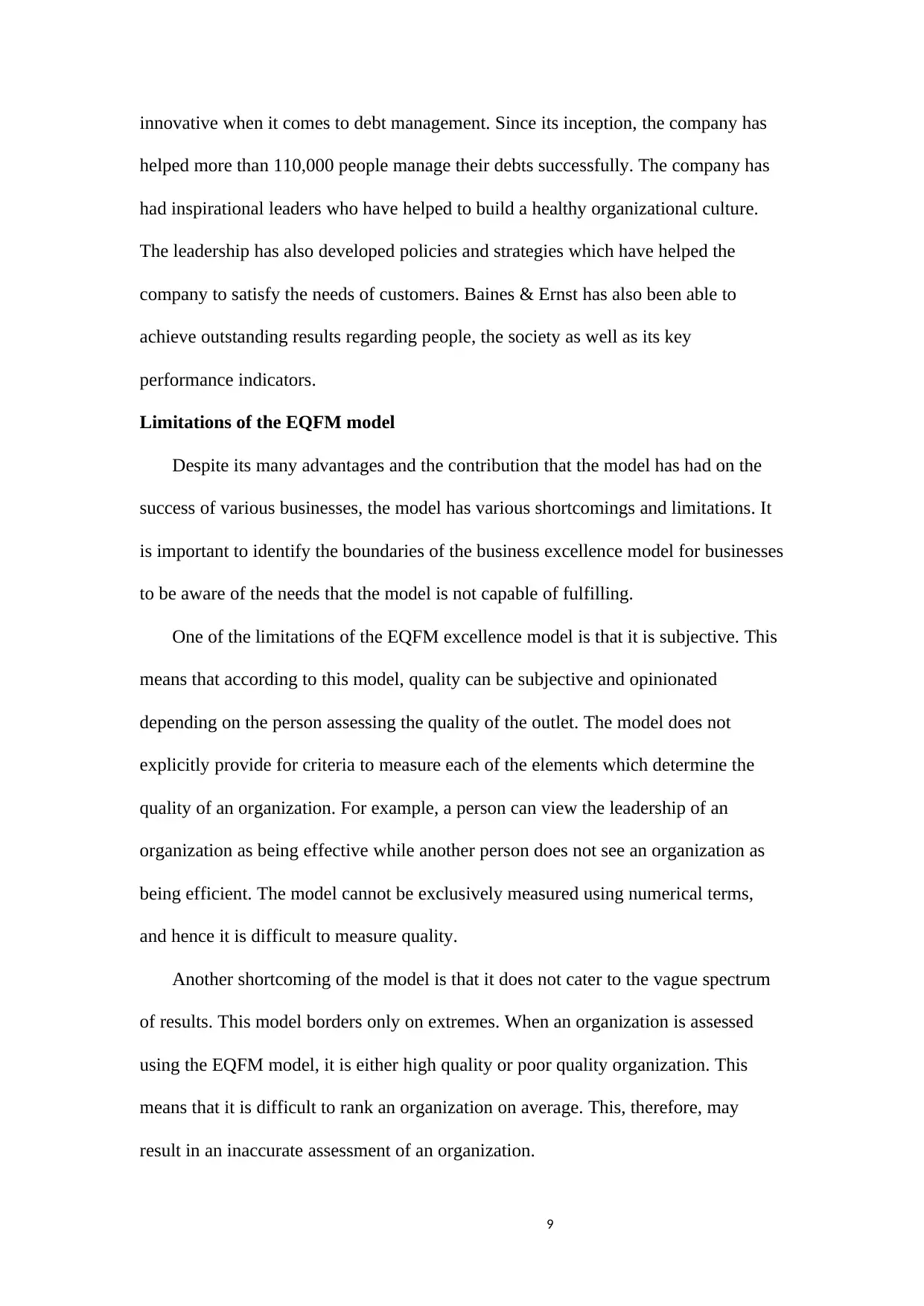
9
innovative when it comes to debt management. Since its inception, the company has
helped more than 110,000 people manage their debts successfully. The company has
had inspirational leaders who have helped to build a healthy organizational culture.
The leadership has also developed policies and strategies which have helped the
company to satisfy the needs of customers. Baines & Ernst has also been able to
achieve outstanding results regarding people, the society as well as its key
performance indicators.
Limitations of the EQFM model
Despite its many advantages and the contribution that the model has had on the
success of various businesses, the model has various shortcomings and limitations. It
is important to identify the boundaries of the business excellence model for businesses
to be aware of the needs that the model is not capable of fulfilling.
One of the limitations of the EQFM excellence model is that it is subjective. This
means that according to this model, quality can be subjective and opinionated
depending on the person assessing the quality of the outlet. The model does not
explicitly provide for criteria to measure each of the elements which determine the
quality of an organization. For example, a person can view the leadership of an
organization as being effective while another person does not see an organization as
being efficient. The model cannot be exclusively measured using numerical terms,
and hence it is difficult to measure quality.
Another shortcoming of the model is that it does not cater to the vague spectrum
of results. This model borders only on extremes. When an organization is assessed
using the EQFM model, it is either high quality or poor quality organization. This
means that it is difficult to rank an organization on average. This, therefore, may
result in an inaccurate assessment of an organization.
innovative when it comes to debt management. Since its inception, the company has
helped more than 110,000 people manage their debts successfully. The company has
had inspirational leaders who have helped to build a healthy organizational culture.
The leadership has also developed policies and strategies which have helped the
company to satisfy the needs of customers. Baines & Ernst has also been able to
achieve outstanding results regarding people, the society as well as its key
performance indicators.
Limitations of the EQFM model
Despite its many advantages and the contribution that the model has had on the
success of various businesses, the model has various shortcomings and limitations. It
is important to identify the boundaries of the business excellence model for businesses
to be aware of the needs that the model is not capable of fulfilling.
One of the limitations of the EQFM excellence model is that it is subjective. This
means that according to this model, quality can be subjective and opinionated
depending on the person assessing the quality of the outlet. The model does not
explicitly provide for criteria to measure each of the elements which determine the
quality of an organization. For example, a person can view the leadership of an
organization as being effective while another person does not see an organization as
being efficient. The model cannot be exclusively measured using numerical terms,
and hence it is difficult to measure quality.
Another shortcoming of the model is that it does not cater to the vague spectrum
of results. This model borders only on extremes. When an organization is assessed
using the EQFM model, it is either high quality or poor quality organization. This
means that it is difficult to rank an organization on average. This, therefore, may
result in an inaccurate assessment of an organization.
⊘ This is a preview!⊘
Do you want full access?
Subscribe today to unlock all pages.

Trusted by 1+ million students worldwide
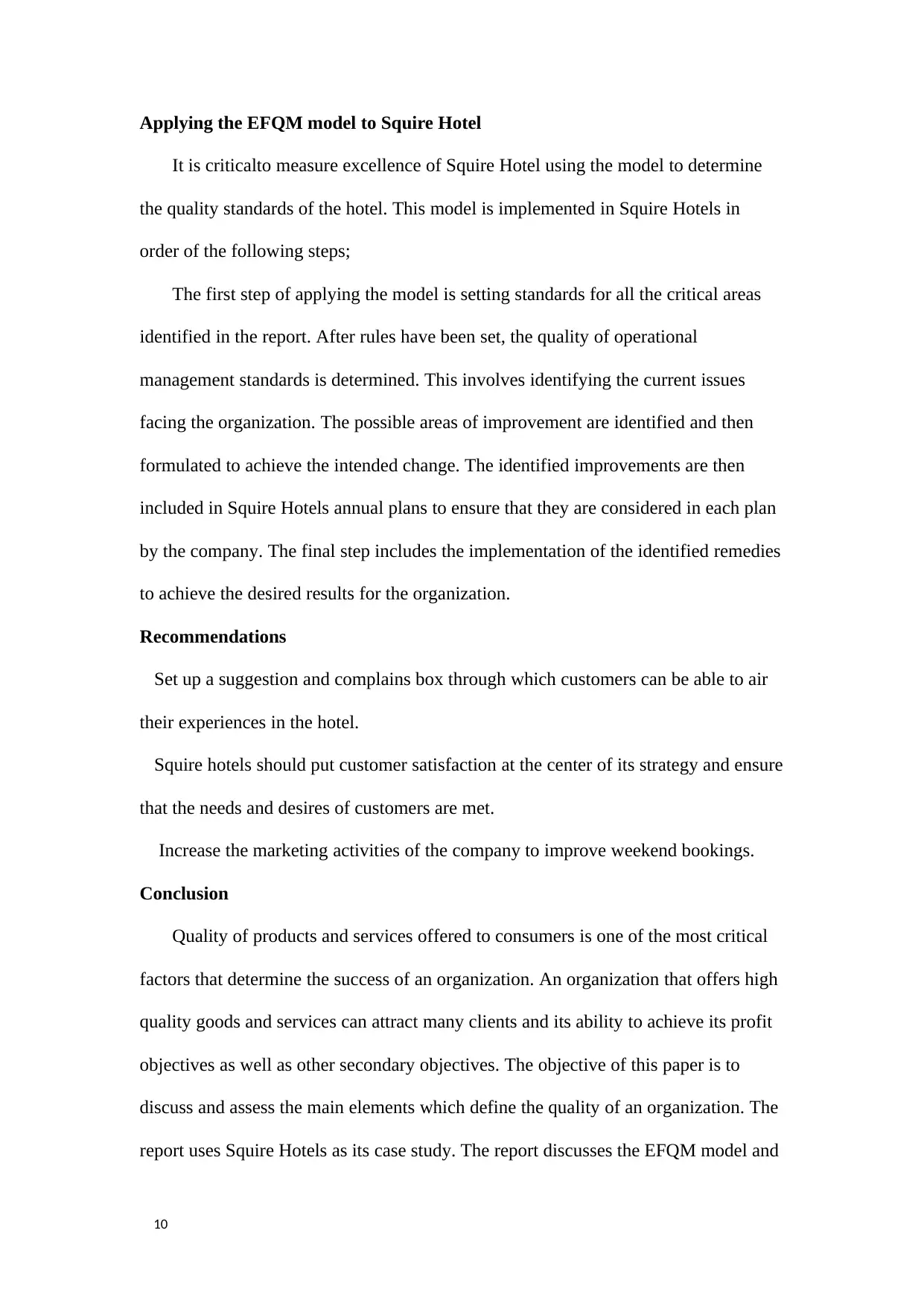
10
Applying the EFQM model to Squire Hotel
It is criticalto measure excellence of Squire Hotel using the model to determine
the quality standards of the hotel. This model is implemented in Squire Hotels in
order of the following steps;
The first step of applying the model is setting standards for all the critical areas
identified in the report. After rules have been set, the quality of operational
management standards is determined. This involves identifying the current issues
facing the organization. The possible areas of improvement are identified and then
formulated to achieve the intended change. The identified improvements are then
included in Squire Hotels annual plans to ensure that they are considered in each plan
by the company. The final step includes the implementation of the identified remedies
to achieve the desired results for the organization.
Recommendations
Set up a suggestion and complains box through which customers can be able to air
their experiences in the hotel.
Squire hotels should put customer satisfaction at the center of its strategy and ensure
that the needs and desires of customers are met.
Increase the marketing activities of the company to improve weekend bookings.
Conclusion
Quality of products and services offered to consumers is one of the most critical
factors that determine the success of an organization. An organization that offers high
quality goods and services can attract many clients and its ability to achieve its profit
objectives as well as other secondary objectives. The objective of this paper is to
discuss and assess the main elements which define the quality of an organization. The
report uses Squire Hotels as its case study. The report discusses the EFQM model and
Applying the EFQM model to Squire Hotel
It is criticalto measure excellence of Squire Hotel using the model to determine
the quality standards of the hotel. This model is implemented in Squire Hotels in
order of the following steps;
The first step of applying the model is setting standards for all the critical areas
identified in the report. After rules have been set, the quality of operational
management standards is determined. This involves identifying the current issues
facing the organization. The possible areas of improvement are identified and then
formulated to achieve the intended change. The identified improvements are then
included in Squire Hotels annual plans to ensure that they are considered in each plan
by the company. The final step includes the implementation of the identified remedies
to achieve the desired results for the organization.
Recommendations
Set up a suggestion and complains box through which customers can be able to air
their experiences in the hotel.
Squire hotels should put customer satisfaction at the center of its strategy and ensure
that the needs and desires of customers are met.
Increase the marketing activities of the company to improve weekend bookings.
Conclusion
Quality of products and services offered to consumers is one of the most critical
factors that determine the success of an organization. An organization that offers high
quality goods and services can attract many clients and its ability to achieve its profit
objectives as well as other secondary objectives. The objective of this paper is to
discuss and assess the main elements which define the quality of an organization. The
report uses Squire Hotels as its case study. The report discusses the EFQM model and
Paraphrase This Document
Need a fresh take? Get an instant paraphrase of this document with our AI Paraphraser
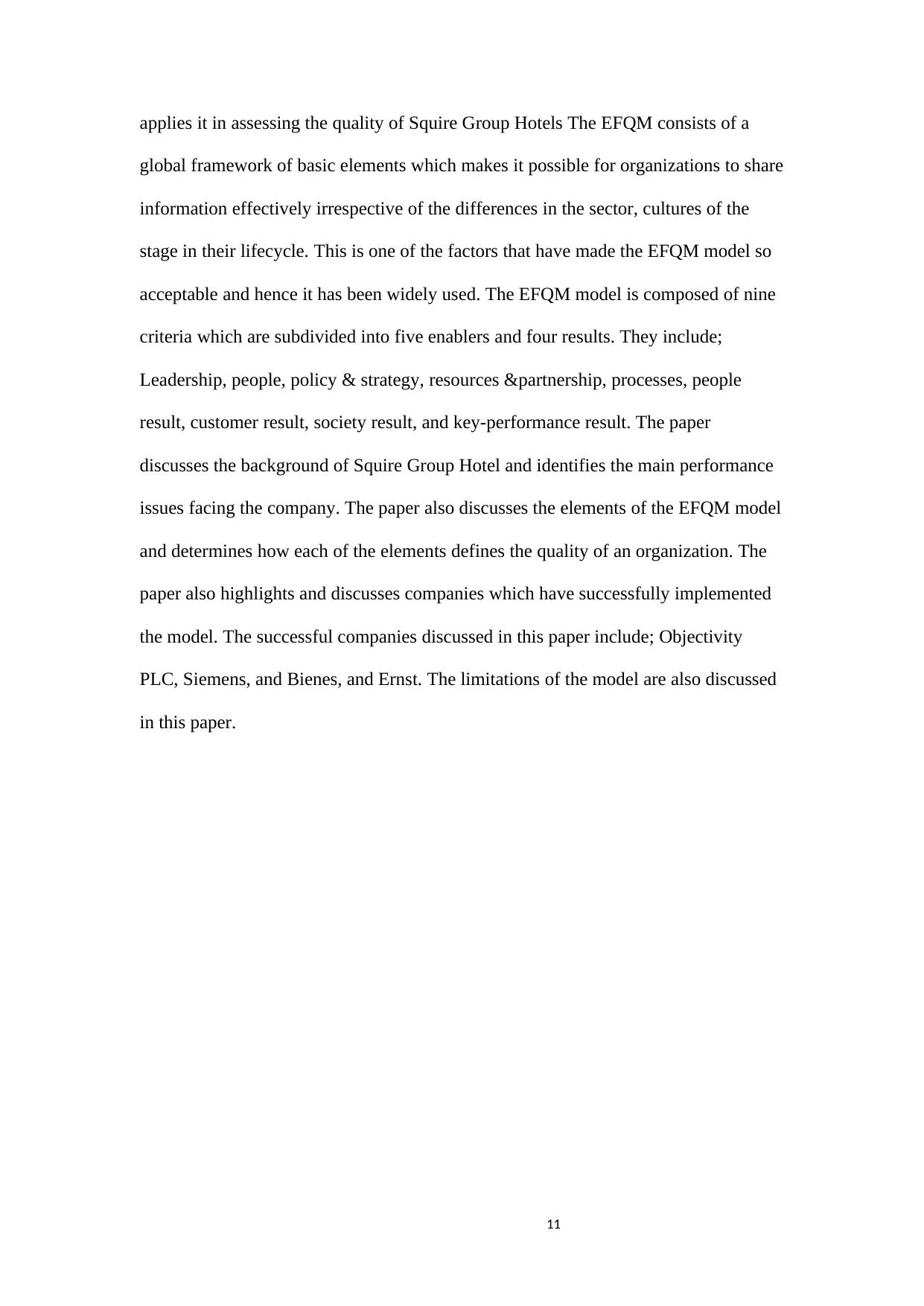
11
applies it in assessing the quality of Squire Group Hotels The EFQM consists of a
global framework of basic elements which makes it possible for organizations to share
information effectively irrespective of the differences in the sector, cultures of the
stage in their lifecycle. This is one of the factors that have made the EFQM model so
acceptable and hence it has been widely used. The EFQM model is composed of nine
criteria which are subdivided into five enablers and four results. They include;
Leadership, people, policy & strategy, resources &partnership, processes, people
result, customer result, society result, and key-performance result. The paper
discusses the background of Squire Group Hotel and identifies the main performance
issues facing the company. The paper also discusses the elements of the EFQM model
and determines how each of the elements defines the quality of an organization. The
paper also highlights and discusses companies which have successfully implemented
the model. The successful companies discussed in this paper include; Objectivity
PLC, Siemens, and Bienes, and Ernst. The limitations of the model are also discussed
in this paper.
applies it in assessing the quality of Squire Group Hotels The EFQM consists of a
global framework of basic elements which makes it possible for organizations to share
information effectively irrespective of the differences in the sector, cultures of the
stage in their lifecycle. This is one of the factors that have made the EFQM model so
acceptable and hence it has been widely used. The EFQM model is composed of nine
criteria which are subdivided into five enablers and four results. They include;
Leadership, people, policy & strategy, resources &partnership, processes, people
result, customer result, society result, and key-performance result. The paper
discusses the background of Squire Group Hotel and identifies the main performance
issues facing the company. The paper also discusses the elements of the EFQM model
and determines how each of the elements defines the quality of an organization. The
paper also highlights and discusses companies which have successfully implemented
the model. The successful companies discussed in this paper include; Objectivity
PLC, Siemens, and Bienes, and Ernst. The limitations of the model are also discussed
in this paper.

12
⊘ This is a preview!⊘
Do you want full access?
Subscribe today to unlock all pages.

Trusted by 1+ million students worldwide
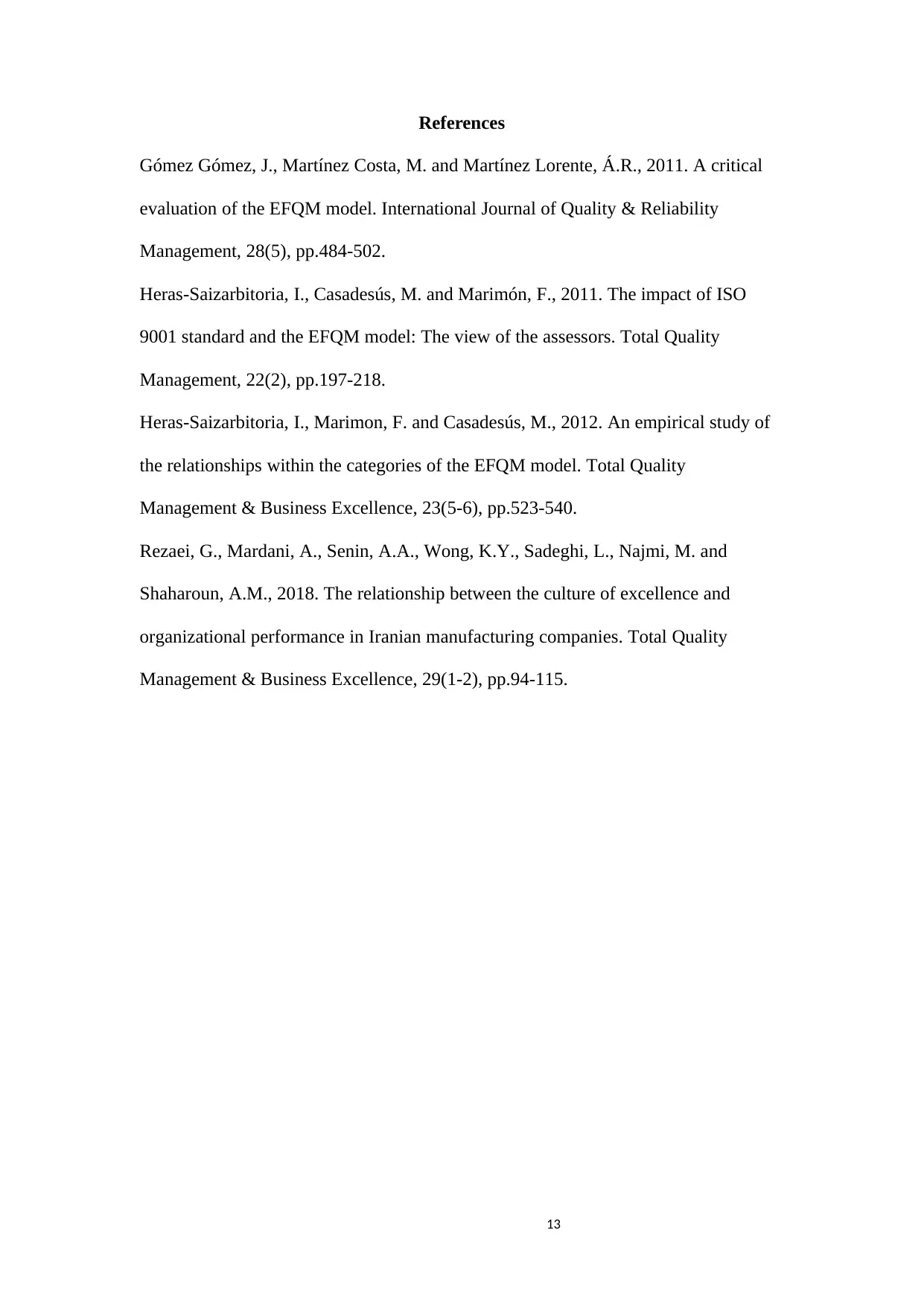
13
References
Gómez Gómez, J., Martínez Costa, M. and Martínez Lorente, Á.R., 2011. A critical
evaluation of the EFQM model. International Journal of Quality & Reliability
Management, 28(5), pp.484-502.
Heras-Saizarbitoria, I., Casadesús, M. and Marimón, F., 2011. The impact of ISO
9001 standard and the EFQM model: The view of the assessors. Total Quality
Management, 22(2), pp.197-218.
Heras-Saizarbitoria, I., Marimon, F. and Casadesús, M., 2012. An empirical study of
the relationships within the categories of the EFQM model. Total Quality
Management & Business Excellence, 23(5-6), pp.523-540.
Rezaei, G., Mardani, A., Senin, A.A., Wong, K.Y., Sadeghi, L., Najmi, M. and
Shaharoun, A.M., 2018. The relationship between the culture of excellence and
organizational performance in Iranian manufacturing companies. Total Quality
Management & Business Excellence, 29(1-2), pp.94-115.
References
Gómez Gómez, J., Martínez Costa, M. and Martínez Lorente, Á.R., 2011. A critical
evaluation of the EFQM model. International Journal of Quality & Reliability
Management, 28(5), pp.484-502.
Heras-Saizarbitoria, I., Casadesús, M. and Marimón, F., 2011. The impact of ISO
9001 standard and the EFQM model: The view of the assessors. Total Quality
Management, 22(2), pp.197-218.
Heras-Saizarbitoria, I., Marimon, F. and Casadesús, M., 2012. An empirical study of
the relationships within the categories of the EFQM model. Total Quality
Management & Business Excellence, 23(5-6), pp.523-540.
Rezaei, G., Mardani, A., Senin, A.A., Wong, K.Y., Sadeghi, L., Najmi, M. and
Shaharoun, A.M., 2018. The relationship between the culture of excellence and
organizational performance in Iranian manufacturing companies. Total Quality
Management & Business Excellence, 29(1-2), pp.94-115.
1 out of 16
Related Documents
Your All-in-One AI-Powered Toolkit for Academic Success.
+13062052269
info@desklib.com
Available 24*7 on WhatsApp / Email
![[object Object]](/_next/static/media/star-bottom.7253800d.svg)
Unlock your academic potential
© 2024 | Zucol Services PVT LTD | All rights reserved.





